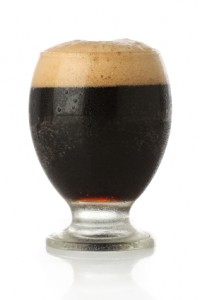 Some time ago I wrote an article on steeping vs mashing dark grains for all grain beer brewers. That article recommended steeping some dark grains into a separate tea to minimize burnt, harsh flavors. This week we take a look at a simpler method for achieving the same effect.
Some time ago I wrote an article on steeping vs mashing dark grains for all grain beer brewers. That article recommended steeping some dark grains into a separate tea to minimize burnt, harsh flavors. This week we take a look at a simpler method for achieving the same effect.
Steeping vs Mashing Dark Grains
As I mentioned in my original article, mashing darker grains can result in deep roast flavor, it can also result in overly harsh character in some beers – particularly when you are looking for a roast flavor. I compare it to percolating coffee for too long. Leaving dark roasted grains in the mash for 60-90 minutes can result in burnt, harsh, bitter flavors that you don’t get from a short steep in hot water.
In the original article I recommended separating the dark grains, which contribute relatively few fermentable sugars, into a separate tea made with hot water in a grain bag. That way you can steep your dark grains for a more appropriate 10-20 minute period and then simply add the tea to your kettle after mashing and sparging.
A Better Way of Steeping Dark Grains
This year was having dinner with Gordon Strong, who originally wrote about this technique, and he suggested a new method that is much simpler. Rather than preparing a separate tea from the grains, he suggested just adding your dark grains to the top of the mash tun at the end of the mash. This way they get steeped for an appropriately short timeframe, but you avoid the extra work of bagging grains, preparing a separate tea and having to account for additions at the end.
I really like this idea as it gives you full control over the steep time, with none of the mess. You don’t have to change your mash-in schedule – just use the lighter grains for the calculation and honestly the mash out changes very little since the volume of dark grains is small in most cases. At worst you may need to add a few quarts of sparge water to account for the water absorped by the dark grains added.
So that’s a quick way to include dark grains in your beer without adding some of the harsh flavors that can come from mashing them too long. Thanks for joining me on the BeerSmith Home Brewing Blog. Be sure to sign up for my newsletter or my podcast (also on itunes…and youtube…and streaming radio station) for more great tips on homebrewing.
I used another very valid method: Dark malts infusion in cold water, the day before (maceration for 24 hours). This method is valid only when you want to limit color and toasted flavor. Greetings from South Italy!
How does this affect the pH of the mash? Should I set Bru’n Water to use the dark malts in the whole mash? Exclude them from the calculations? Something else? Thanks!
Oops … it was already treated by you in another article, I saw just now. I have a question for you: I thought of a sort of pre-decoction with caramel malts, bring to a boil and then add during the mash, to have more production melanoidine .. would be an interesting way?
The dark grains would drive the mash pH down, but if you save them to the end obviously your mash pH is going to be higher. You can probably exclude them from calculations for the main mash if estimating pH.
How would adding dark grains at the end of a mash be accounted for in the BeerSmith? Or by virtue of telling the program that these dark grains are in the mash, it already assumes that the minimal amount of sugars are being extracted even if it was in for the full mash?
Currently they are assumed to be in the full mash which may throw your infusion calcs off just a bit if you add them late. I’m working on a new version that lets you mark them to be steeped at the end of the mash.
Does the newest version of BS accommodate for steeped grains?
When steeping roasted grains like this as opposed to including them in the full mash, would I have to increase the amount of roasted grains in the recipe to compensate for the decreased mashing time and get the same amount of color and flavor from them?
Thanks
When steeping dark grains at the end of the mash, do I have to increase the amount of dark grains in the recipe to compensate for the shorter soaking time to maintain the same intensity of flavor and color?
Thanks.